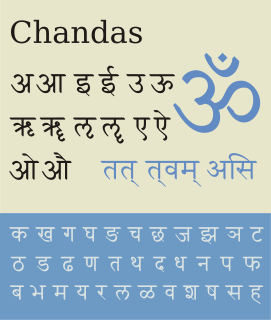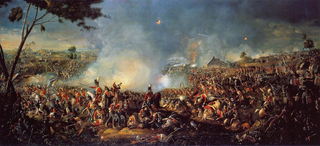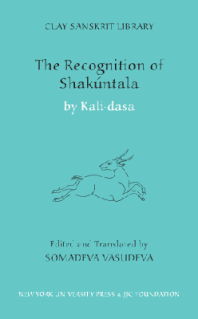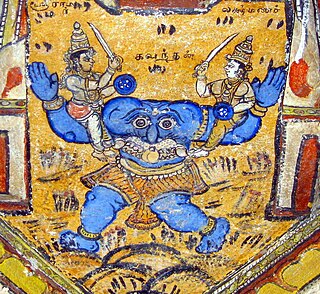The Anargharāghava (Devanagari अनर्घराघव) is a dramatised retelling of the Ramayana, and one of the most challenging pieces of classical Sanskrit poetry. It is the only surviving work by Murāri, a Brahmin court poet, who lived some time between the 8th and 10th century CE, perhaps in Orissa or in neighbouring South India.

Devanagari, also called Nagari, is a left-to-right abugida (alphasyllabary), based on the ancient Brāhmī script, used in the Indian subcontinent. It was developed in ancient India from the 1st to the 4th century CE, and was in regular use by the 7th century CE. The Devanagari script, composed of 47 primary characters including 14 vowels and 33 consonants, is one of the most adopted writing systems in the world, being used for over 120 languages. The ancient Nagari script for Sanskrit had two additional consonantal characters.

Ramayana is one of the two major Sanskrit epics of ancient India, the other being the Mahābhārata. Along with the Mahābhārata, it forms the Hindu Itihasa.
Contents
Because of its elegant style, learned allusions and often striking imagery, the poem has been a great favourite among pandits [ who? ], although it received little attention in the West until recently. The well-known epic story of Rama’s exploits is presented as a series of political intrigues and battles, and contrasted with lyrical passages of various kinds: on love and war, pride and honor, gods and demons, rites and myths, regions and cities of ancient India.

A battle is a combat in warfare between two or more armed forces, or combatants. A war usually consists of multiple battles. Battles generally are well defined in duration, area, and force commitment. A battle with only limited engagement between the forces and without decisive results is sometimes called a skirmish.

Pride is an inwardly directed emotion that carries two antithetical meanings. With a negative connotation pride refers to a foolishly and irrationally corrupt sense of one's personal value, status or accomplishments, used synonymously with hubris. In Judaism, pride is called the root of all evil. With a positive connotation, pride refers to a humble and content sense of attachment toward one's own or another's choices and actions, or toward a whole group of people, and is a product of praise, independent self-reflection, and a fulfilled feeling of belonging.
A deity is a supernatural being considered divine or sacred. The Oxford Dictionary of English defines deity as "a god or goddess ", or anything revered as divine. C. Scott Littleton defines a deity as "a being with powers greater than those of ordinary humans, but who interacts with humans, positively or negatively, in ways that carry humans to new levels of consciousness, beyond the grounded preoccupations of ordinary life". In the English language, a male deity is referred to as a god, while a female deity is referred to as a goddess.
The play has little action — most fights and events take place behind the scenes or between acts — focussing instead on diction and other elements of dramatic representation, reminiscent of the Keralan Kutiyattam tradition. Although Kutiyattam representations are envisaged for dramas with more action than the Anargharāghava, actual performances — which normally include only one episode of a play at one go — often resemble spectacular chanting recitations of poetry interspersed with well-choreographed movements rather than what one would normally call theatre.
Murāri's emphasis on writing a play rather than a series of beautiful stanzas is also seen in the numerous allusions to plays and theatre. In the Prakrit-Sanskrit prelude of Act 4, entitled miśraviṣkambhaka, Mālyavan, the great intriguer of the demons, Rāvaṇa’s minister, is angry with Vishvāmitra, who is directing a ‘bad drama’, durnāṭaka, a play which is altogether against Mālyavan’s will. The expression is made more explicit by one of the commentators, Vishnubhatta, who gives the following paraphrase: he Vishvāmitra directs everything himself, just as a stage-manager does (svayaṃ sūtradhāravat sarvapreraka iti bhāvaḥ). In presenting the Rama-story as a story of intrigues, Murāri follows the tradition of Bhavabhuti’s Mahāvīracarita, but renews it with his parallels from the world of stage.

Brahmarshi Vishvamitra is one of the most venerated rishis or sages of ancient India. He is also credited as the author of most of Mandala 3 of the Rigveda, including Gayatri Mantra. The Puranas mention that only 24 rishis since antiquity have understood the whole meaning of—and thus wielded the whole power of—Gayatri Mantra. Vishvamitra is supposed to be the first, and Yajnavalkya the last.
Bhavabhuti was an 8th-century scholar of India noted for his plays and poetry, written in Sanskrit. His plays are considered equivalent to the works of Kalidasa. Bhavbhuti was born in Padmapura, Vidarbha, in Gondia district, on Maharashtra and Madhya Pradesh border. His real name was Srikantha Nilakantha, and he was the son of Nilakantha and Jatukarni. He received his education at 'Padmapawaya', a place some 42 km South-West of Gwalior. Paramhans Dnyananidhi is known to be his guru. He composed his historical plays at 'Kalpi', a place on banks of river Yamuna.











